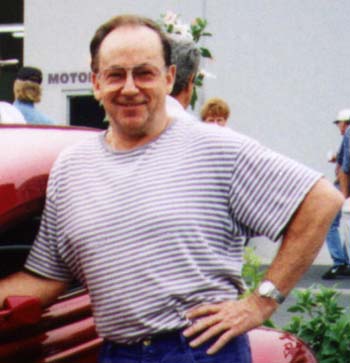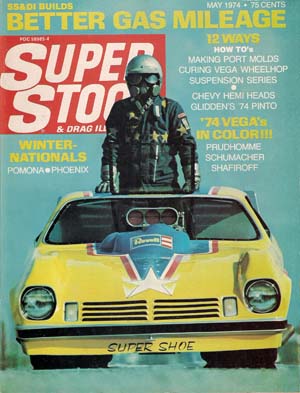SS&DI: HAS IT BEEN 45 YEARS?
Fri, 2009-02-13 11:29
 Jim Davis smiles when reminded that he was a part of something great.
This summer will mark the 45th anniversary of the day he and Monk
Reynolds made the calculated decision to upgrade their weekly racing
newspaper to a full-fledged, newsstand magazine focusing on doorslammer
racing on the east coast and beyond.
Jim Davis smiles when reminded that he was a part of something great.
This summer will mark the 45th anniversary of the day he and Monk
Reynolds made the calculated decision to upgrade their weekly racing
newspaper to a full-fledged, newsstand magazine focusing on doorslammer
racing on the east coast and beyond. Until that time, their racing newspaper was seasonal, with Davis working part-time and Reynolds full-time through the racing season. Reynolds would seek an outside job to fill the void until racing season began again.
Reynolds suggested they do a year-round publication, Davis agreed, and thus was born one of the greatest hardcore drag racing magazines to ever grace the newsstands.
“At the time (Monk) made the suggestion, the Super Stockers were real big on the east coast,” Davis recalled. “Most of the magazines were based in California and covered what was going on out there. There were a few New York-based publications but they mimicked what the west coast magazines were doing.” Co-founder of the Magazine Remembers A Different Era in Drag Racing Magazines …
 Jim Davis smiles when reminded that he was a part of something great. This summer will mark the 45th anniversary of the day he and Monk Reynolds made the calculated decision to upgrade their weekly racing newspaper to a full-fledged, newsstand magazine focusing on doorslammer racing on the east coast and beyond.
Jim Davis smiles when reminded that he was a part of something great. This summer will mark the 45th anniversary of the day he and Monk Reynolds made the calculated decision to upgrade their weekly racing newspaper to a full-fledged, newsstand magazine focusing on doorslammer racing on the east coast and beyond. Until that time, their racing newspaper was seasonal, with Davis working part-time and Reynolds full-time through the racing season. Reynolds would seek an outside job to fill the void until racing season began again.
Reynolds suggested they do a year-round publication, Davis agreed, and thus was born one of the greatest hardcore drag racing magazines to ever grace the newsstands.
“At the time (Monk) made the suggestion, the Super Stockers were real big on the east coast,” Davis recalled. “Most of the magazines were based in California and covered what was going on out there. There were a few New York-based publications but they mimicked what the west coast magazines were doing.”
On the east coast, Super Stock was king.
“No one was really addressing the Super Stock market,” Davis added. “The funny thing is when we started the magazine is when they [Super Stockers] began drifting towards A/FX. That eventually led to the Funny Cars.”
Even as the Super Stockers faded into second class status, Davis and the team at SS&DI, found a way to include all forms of drag racing, while keeping a primary focus on doorslammer racing.
In a roundabout way, Davis and Reynolds didn’t have to go west to the drag racing, it came to them. Many of the west coast teams traveled east because the large paydays were on the right coast.
Super Stock, largely embedded on the east coast, became more of a drag racing magazine and it branched off into pimping match racers and later promoting one of the largest events in 1960s drag racing history.
“It was a pretty lucrative side business,” Davis admitted. “At one time, within a 200-mile radius of our offices, we had nearly 17 drag strips.”
 On any given night one could travel out to these tracks and watch Ronnie Sox race Dave Strickler and more times than not, the gang at SS&DI had a hand in making it happen. Then Funny Cars began replacing the Super Stockers and Top Fuel dragsters became more main-stream.
On any given night one could travel out to these tracks and watch Ronnie Sox race Dave Strickler and more times than not, the gang at SS&DI had a hand in making it happen. Then Funny Cars began replacing the Super Stockers and Top Fuel dragsters became more main-stream. “We had good relationships with the Funny Car guys because we covered them more than the average magazine,” Davis said. “We’d take about five percent of the fee.”
Booking the racers was one idea that supplemented the income of the publication, but their wildest idea became a reality when in 1965, Davis and Reynolds staged the largest single day drag race – a race known simply as the Super Stock Nationals and hosted by York, Pennsylvania’s U.S. 30 Dragway.
It became clear early in the game, the partners had bitten off more than they could chew.
“That was a bright idea,” Davis added, voice cracking with laughter.
Davis will be the first to admit they underestimated the value of the event and prepared for 5,000 – 10,000 fans and a handful of race cars.
“There was five times more people in the grandstands than they could hold and five times more cars than the pits had ever parked,” Davis recalled. It was the "Woodstock" of drag even before Woodstock had actually occurred.
“We never got a real good count of people because many of them got tired of waiting in the ticket line and just came on in. We had cars parked on the side of U.S. 30 for about three miles.”
The event continued well into the 1980s and the magazine, it drew to a painful close late in the 1990s, the victim of multiples changes of ownership, not to mention the declining value of printed drag racing magazines. The fact SS&DI held on to the mantra of “telling it like it is” well into the politically correct era didn’t help its survival.
Then the internet age came along further complicating matters.
Davis was long gone from the drag racing magazine industry by the time those issues flared up.
Thinking back to one summer in Alexandria, Va., Davis remembers when they produced the famous August 1964 issue, with Ronnie Sox’s new A/FX Comet on the cover; the very first issue of Super Stock and Drag Illustrated.
Davis admittedly wasn’t a collector of those prized SS&DI magazines, and left the team in the late 1960s, settling for a buyout from Reynolds.
Now the Chief Operating Officer for Professional Products in Hawthorne, Ca., Davis attended a classic car swap meet about ten years ago and happened across that debut issue. The ironic part about the chance encounter is that, at that time, he wasn’t even looking for magazines.
“I walked by this one booth and this guy had literally thousands of racing magazines,” Davis said. “He had a lot of Super Stocks and in particularly had one in a plastic envelope. It had a $50 price tag on it.”
Davis played it like a true publisher, he knew the value of the magazine, yet played the role of a novice.
“I asked the guy why that magazine was so expensive,” Davis said. “He told me it was the first issue and I responded that I would like the magazine, but wasn’t willing to pay that much for it. I offered $30 and he took it. I never told him that I would have paid $50 for it.”
That magazine is tucked away in his desk drawer, a reminder of what two guys with a vision and a niche market that needed to be filled could accomplish.
In case you’re wondering, that magazine is not for sale – for any price.
“I won’t sell it,” Davis admitted. “But I would love to get the first issue of Stock Car Racing magazine, that's the other magazine we started.”
Even though his story is chronicled via the internet, there’s a place in his heart reserved for the print magazines.
“I still prefer the print media because I like to hold something in my hand,” Davis admits. “Unfortunately I think that will go away because that’s the way the industry is turning. I can accept change and this appears to be one, we just have to keep moving forward.”
Categories:



































